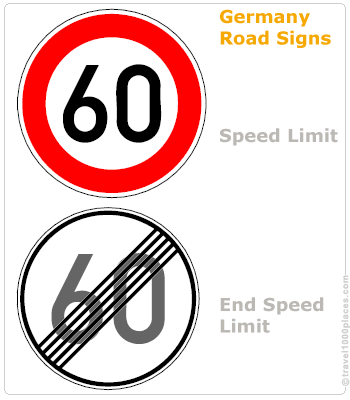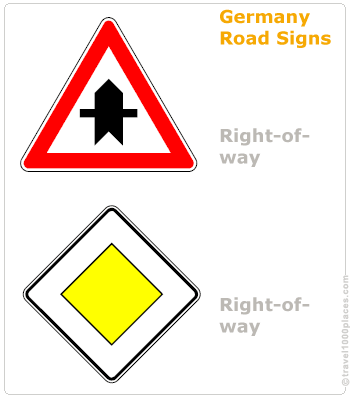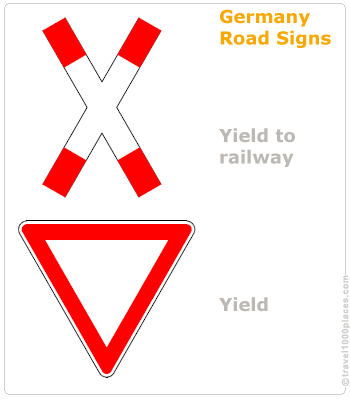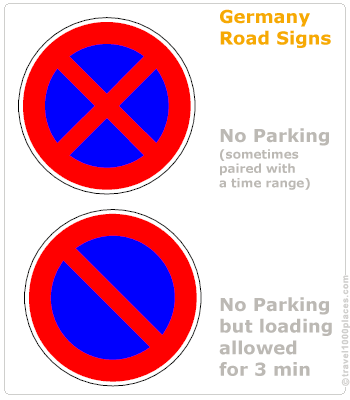



Germany has an excellent road system and getting around by car is an easy undertaking.
Rules and Street Signs
Germany deploys an international set of road signs which are basically self-explaining for a visitor. It can be assumed that no tourist really wants to learn all the rules in detail. We are not aware of an official translation otherwise we would post it here on this page. In German that official set of rules is called “Straßenverkehrsordnung”.
German drivers can be classified as quite disciplined, however, especially on the Autobahn traffic can be very fast.
In cities there is a general speed limit of 50 km/h (ca. 30 mph) if not otherwise posted. Outside of city limits there is a general speed limit of 100 km/h (ca. 80 mph) unless otherwise posted. The German government recommends a speed of 130 km/h for Autobahns but as the name says it is a recommendation.
We’d like to mention one specific rule which is not existing in many other countries: “Rechts-vor-Links”.
This means that on streets where is no sign regulating the right-of-way then the “rechts-vor-links” rule which means ‘right-before-left’ is applied.
Assume you are driving on a street and you are approaching a side street. If there’s no traffic light or stop sign or “Vorfahrtsschild” (right-of-way sign) on your street then the car approaching from the side street has the right-of-way because that person comes from your right side. Form taht car’s perspective you are coming from the left side. Does that make sense? Sounds difficult, does it? Actually it takes some time for a driver to adopt that rule and requires full attention of the driver at any times in order to detect such ‘rechts-vor-links’ streets.
Gas
Germany has a dense net of gas stations. They carry usually all types of gasoline, diesel, and alternative products. However, gas is expensive in Germany: They measure in “Liter” and not in gallons. A liter of gas costs approx. 1.30 Euro up to 1.50 Euro. This translates to ca. 5 U.S. Dollars per gallon.
Bicycles & Bicycle Lanes
Many German streets and sidewalks have dedicated bike lanes for use by bicyclists. Pedestrians should be aware that bicycles have priority use of these lanes and should be careful to observe whether any bicyclist is approaching before crossing or stepping into the bike lane. Bicyclists also have priority over cars turning onto side streets, and motorists should always confirm whether a bicyclist is approaching from either direction before attempting to enter side streets, even when the light is in their favor. Motorists turning into a side street who hit a bicyclist who is using a marked bike lane will be held responsible for any injury or damage caused. The use of cell phones while driving is prohibited in Germany.
Railroad crossings
Travelers should also note that railroad crossings are marked differently in Germany than in e.g. the U.S.
In addition to the standard crossbuck (X-shaped) sign, railroad crossings are often marked by signal lights. Signal lights at a railroad crossing means that a train is approaching and that all vehicles should stop.
More information
Further below you find the web address of the German Government website in charge for road, traffic, etc. (Unfortunately we have not found an English translation. If you do know about an official one please send us an email.)
When getting your rental car ask your rental car company if they have a summary sheet or booklet with traffic signs and rules.
Some external websites which provide further information
German Traffic Laws and Fines
www.bussgeldkatalog.org/german-driving-laws/
German Road and Traffic Regulations (Federal Ministry of Transport)
www.bmvi.de/SharedDocs/EN/publications/german-road-traffic-regulations.pdf
The U.S. Consulates in Germany have published comprehensive information:
https://de.usembassy.gov/u-s-citizen-services/driving-in-germany/

